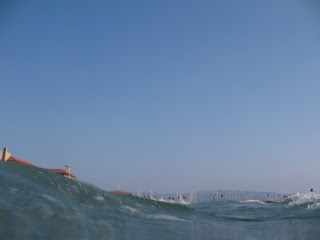Recently
I had the opportunity to accompany fellow artist/illustrator and friend Mark
Klingler on a duck photo field trip to Presque Isle in Eerie, PA. Mark was one of the first scientific illustrators I'd met, an excellent teacher and avid
ducker as well. Mark’s day job is rendering dinosaurs for various
paleontologists at the Carnegie Museum of Natural History.
 |
| Millions of Gizzard Shad line the shoreline |
It's
still pretty brisk out on the great lakes in mid-March, but the variety of
ducks was an eye opener. I've been aware (from reading bird books) that there
are a variety of ducks in the world beyond your standard mallard, but I was
pleasantly surprised to find such a rich diversity of geese and ducks so close
to home.
Because
of the cold temperatures and lack of ice on the lake, there was also a massive
die off of gizzard shad and the beaches were littered with dead fish for miles.
A little unsettling to think you are walking on a snowy beach only to find
frozen fish underfoot! This is a natural phenomenon brought on by the wintery
temperatures, but still very unsettling...and a bit smelly.
Since
it was so cold, we concentrated on recording duck behavior via camera for later
drawings. Mark's camera skills are superior to mine, but even my blurry photos
are enough to work from for quick studies. I mention this just in case you
might be thinking you need to be Ansel Adams as well as Picasso. Your own photos are excellent resources for drawing and painting. I see so many of my students working from images from magazines, books or other photographers work, which is a no-no. You can't sell a painting that is just a copy of another persons work. But you dont have to be an expert with a camera yourself. And your skill will improve as you practice.
 |
| Red-breasted Mergansers |
You'll also notice I've taken the liberty to move the female ducks a bit closer to the males for the sake of composition. Don't feel married to the snapshot, as it is. You can take bits and pieces from several of your photos to create a solid composition.
 |
| Northern Shovelers |
You'll
notice the different bills on each species, but particularly the Northern
Shoveler which has a wide fat spoon shaped bill. Their common feeding habit is
to filter food from water through their bills which have comb-like projections
along the edges.
 |
| Hooded Mergansers |
A
nice surprise was these Hooded Mergansers. At the time we were snapping
pictures, this gathering was well away on the other side of the lake and my
telephoto lens was struggling to get a lock. At the time I thought they might
be Buffle heads, but zooming in on it in Photoshop, I think they are actually
Hooded Mergansers.
These
quick studies were done with a variety of watercolor pencils. My favorites are
the Stabilo brand (which they unfortunately no longer make). The Derwent
Inktense line is a nice pencil too and I find I am often picking them up.
Eventually, I might work some of the sketches up to a final oil or watercolor painting, but right now this is all I had time to complete. If you are feeling frustrated by the time restraints of doing a full fledge work, try and take a step back. Field sketching and studies might not seem so glorious, but having a solid sketching ability is a foundation for later success.
http://seadragonrealmcom.businesscatalyst.com/realm-of-the-seadragons.html
http://seadragonrealmcom.businesscatalyst.com/realm-of-the-seadragons.html






.jpg)